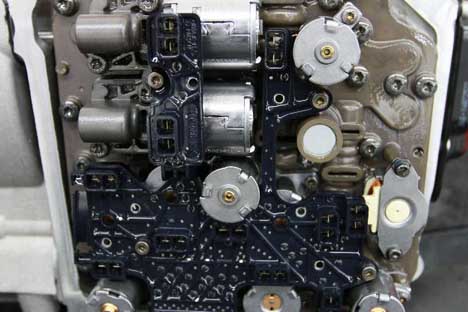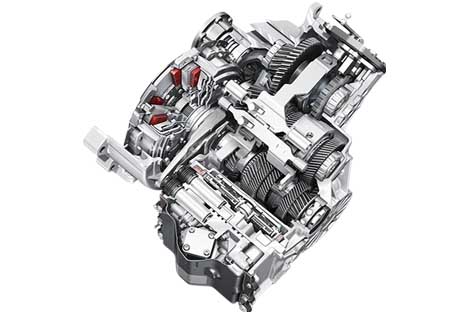DSG Transmissions
A double-clutch system, also known as Direct Shift Gearboxes or DSG transmissions, are essentially manual transmissions that are fully automated.
Like conventional manual transmissions, all the variants of DSG transmissions use solid steel gears that are engaged in different ratios to produce either six or seven speeds, depending on the transmission variant.
How Does A DSG Transmission Work?
The most important differences between DSG and conventional manual transmissions are that DSG transmissions use two clutches that are incorporated into a single assembly, as opposed to a conventional manual transmission that uses only one clutch, and that on some DSG variants, the clutch assembly runs in oil similar to most motor cycle clutches.
In terms of operation, DSG transmissions are highly sophisticated systems that depend on hydraulic actuators to operate both clutches alternatively, as well as other actuators that actually engage and disengage the gears, with the whole being controlled by a control module known as a “mechatronic” unit. In simple terms, mechatronic units can be described as a sometimes-rocky or even unhappy marriage between hydraulic and electronic systems that are intended to work in conjunction with each other to control the transmission, using input data from a wide variety of engine and other sensors when the transmission is in automatic mode.
As a practical matter though, when the transmission is in neutral both clutches are disengaged, but when a gear is selected, the control system selects both first and second gears, and engages the clutch that operates first gear, while keeping the clutch that operates second gear disengaged.
The transmission will now remain in first gear until either the control system initiates a shift to second gear, or the driver initiates a shift to second gear manually. Since second gear is already selected but kept in “reserve” by the transmission’s control system, the system accomplishes the actual shift to second gear simply by disengaging the one clutch while engaging the other.
This arrangement also works for the other gears; when first gear is deselected (and the transmission is in second gear), third gear is selected, but it is kept in reserve by the control system. In this way, there are always two gears selected, but to make the system work, the odd-numbered gears (1, 3, 5, and 7) are operated by one clutch, while the even-numbered gears (2, 4, and 6) are operated by the other clutch. In most variants, reverse gear is also operated by the clutch that operates the odd-numbered gears.
Advantages of DSG transmissions
The practical advantages of DSG transmissions are that the best aspects of both manual and automatic transmissions are incorporated into one single unit, and while this arrangement provides for gear changes that are measured in milliseconds, there are no real, tangible advantages to having a DSG transmission in any vehicle.
Disadvantages of DSG transmissions
Apart from the fact that many users find it very difficult to learn to drive DSG-equipped vehicles efficiently and safely, many variants of DSG transmissions are plagued by constant and recurring defects, failures, and malfunctions, some of which have remained unresolved since DSG transmissions were first introduced in 2003
While no transmission type is perfect, the high incidence of DSG transmission failures (and resultant customer complaints) has caused car manufacturers to recall hundreds of thousands of vehicles over the past few years. In some cases, the issues were resolved with simple software updates, but many persistent reliability issues remain, which collectively, represent the biggest disadvantage of DSG transmissions over other types of transmissions and particularly so in light of the very high costs involved in fixing DSG transmission failures.
Common symptoms of faulty DSG transmissions
The most common symptoms of defects and malfunctions in DSG transmissions are much the same across all variants, regardless of the make and model of the vehicle any given DSG variant is fitted to. These can include the following.
Sudden loss of power
This is arguably the most common failure that afflicts all DSG transmissions, and it is almost invariably caused by a failure of the mechatronic unit. In some cases, and depending on the nature of the mechatronic unit failure, the transmission may be forced into a failsafe or limp mode (often locked into third gear) that will persist until the fault is corrected, or the mechatronic unit is replaced.
Harsh gearshifts
This is most commonly caused by a failure of the control system to modulate clutch engagements as the result of defects in, or malfunctions of the clutch actuators. In most cases, the clutch actuators malfunction as the result of oil pressure control issues. After mechatronic failures, clutch related failures are the next most common issues on DSG transmissions.
Failure to select some gears
While this is most commonly caused by the mechanical failure of one or more transmission components, it can also be caused by failures of, or defects in the clutch assembly. Generally, only odd-numbered, or, even-numbered gears will be affected. However, some failure modes of the clutch assembly will affect all gears.
Mechanical noises
Some DSG variants, particularly the six-speed versions, are prone to premature bearing wear, which causes whining, rumbling, or grinding noises that may or may not be present in all gears.
Excessive vibration
This rarely involves the transmission itself, the most common cause of severe vibration involves failures of the dual-mass flywheels that are used in conjunction with all DSG transmissions. However, while the main problem does not originate in the transmission, subjecting a DSG transmission to these kinds of violent vibrations for extended periods can cause severe, if not always fatal mechanical damage to a DSG transmission.
Cost of replacing a DSG transmission
There are too many variables, such as make, model, and DGS transmission variant for this guide to state even a range of DSG replacement costs. However, in many cases, the failure involves a premature failure of the mechatronic unit, as opposed to the transmission itself failing. In cases where vehicle owners have to pay for new mechatronic units, cost can be in the thousands of rands depending on the vehicle make and model, not including installation.
Bavarian Gearbox offers qualified services to all makes and models no matter what you drive.



